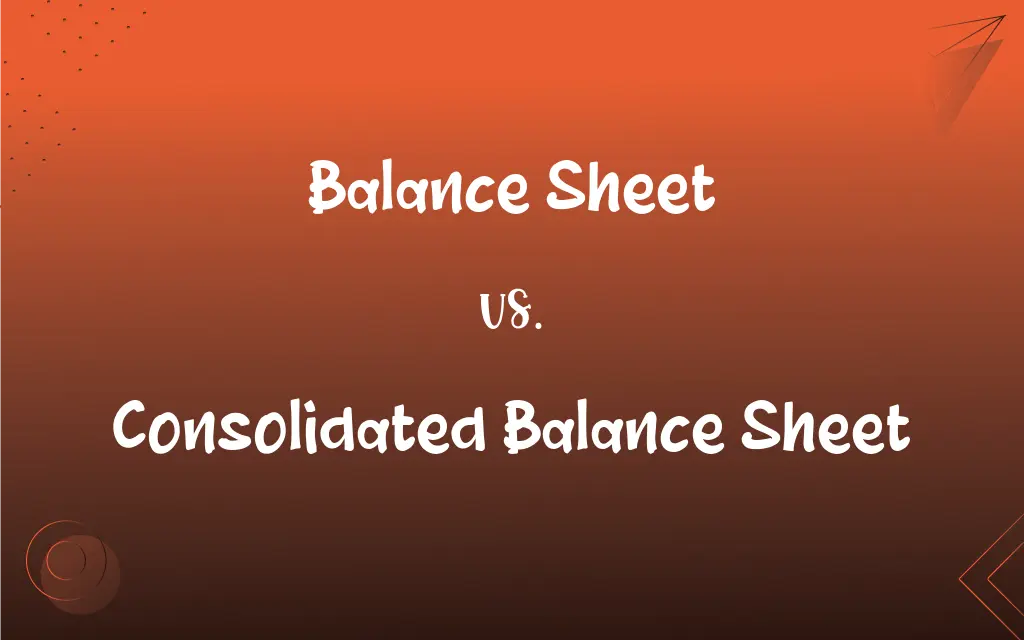Balance Sheet vs. Consolidated Balance Sheet: What's the Difference?
Edited by Aimie Carlson || By Janet White || Published on November 8, 2023
A Balance Sheet presents the financial position of a single entity, while a Consolidated Balance Sheet aggregates the financials of a parent company and its subsidiaries.

Key Differences
The Balance Sheet and Consolidated Balance Sheet are fundamental financial statements, each serving unique purposes in financial reporting. A Balance Sheet gives an overview of an entity's assets, liabilities, and equity at a specific point in time. It reflects the financial position of that individual entity, showcasing what it owns, owes, and the residual interest of its shareholders. On the other hand, the Consolidated Balance Sheet goes a step further by providing a comprehensive view of the entire group's financial position. It aggregates the financial data of a parent company and all its subsidiaries into a single document.
For companies that operate multiple business units or subsidiaries, the Consolidated Balance Sheet is invaluable. It eliminates inter-company transactions and balances, thus avoiding double-counting. While the Balance Sheet of an individual subsidiary might provide insights into its financial health, the Consolidated Balance Sheet gives a holistic picture of the entire corporate group's financial health.
Understanding the distinction between the Balance Sheet and the Consolidated Balance Sheet is crucial for investors and stakeholders. While the Balance Sheet offers transparency into a singular company's finances, the Consolidated Balance Sheet elucidates the combined strength, risks, and opportunities of a group of companies under a single parent. Such a distinction helps in assessing the parent company's ability to leverage resources across its network of subsidiaries.
It's essential to note that while all publicly traded companies must provide a Consolidated Balance Sheet if they have subsidiaries, they may not always present individual Balance Sheets for each subsidiary. Conversely, standalone companies without subsidiaries will only present a Balance Sheet. Both these financial statements are governed by accounting standards and principles, ensuring accuracy and consistency in reporting.
Comparison Chart
Entities Represented
Single entity.
Parent company and all its subsidiaries combined.
ADVERTISEMENT
Inter-Company Transactions
Not applicable.
Eliminated to avoid double-counting.
Purpose
Reflects financial position of one entity.
Provides a holistic view of the entire group's financials.
Stakeholder Relevance
For stakeholders interested in a single entity.
For stakeholders assessing the whole corporate group.
Level of Detail
Detailed for one entity.
Aggregated; specific subsidiary details might be less evident.
Balance Sheet and Consolidated Balance Sheet Definitions
Balance Sheet
A reflection of what a company owns (assets) and owes (liabilities).
By studying the Balance Sheet, creditors assessed the company's ability to pay its debts.
ADVERTISEMENT
Consolidated Balance Sheet
A financial statement aggregating the assets, liabilities, and equity of a parent and its subsidiaries.
XYZ Holdings' Consolidated Balance Sheet displayed a combined asset value from all its subsidiary companies.
Balance Sheet
A financial statement displaying assets, liabilities, and equity at a specific date.
ABC Corp's Balance Sheet showed total assets of $2 million at the end of the fiscal year.
Consolidated Balance Sheet
A tool for assessing the entire group's financial standing, removing internal balances.
Investors often referred to the Consolidated Balance Sheet to gauge the group's overall financial health.
Balance Sheet
A tool that breaks down a company's resources and obligations.
Managers used the Balance Sheet to make informed financial decisions.
Consolidated Balance Sheet
A combined snapshot of a corporate group's financial position.
The Consolidated Balance Sheet gave a comprehensive view of the conglomerate's total financial strength.
Balance Sheet
A snapshot of a company's financial position at a given moment.
The Balance Sheet helped investors understand the company's current financial health.
Consolidated Balance Sheet
A reflection of a group's combined financial resources and obligations.
The Consolidated Balance Sheet highlighted the combined debts of the parent company and its subsidiaries.
Balance Sheet
A statement showing the source and application of funds.
The Balance Sheet revealed a significant increase in long-term debt.
Consolidated Balance Sheet
An aggregated statement that eliminates inter-company transactions.
Inter-company loans were eliminated in the Consolidated Balance Sheet to provide a clear financial picture.
FAQs
What are the main components of a Balance Sheet?
Assets, liabilities, and equity.
Why is a Consolidated Balance Sheet used?
To provide a combined financial view of a parent company and its subsidiaries.
What does a Balance Sheet represent?
It represents an entity's financial position at a specific date.
Can a standalone company have a Consolidated Balance Sheet?
No, only entities with subsidiaries prepare a Consolidated Balance Sheet.
Are inter-company transactions reflected in the Consolidated Balance Sheet?
No, they are eliminated to avoid double-counting.
Do all companies need to prepare a Balance Sheet?
Publicly traded companies and many private ones do; specifics depend on jurisdiction and business type.
Does the Consolidated Balance Sheet show subsidiary-specific details?
It provides a combined view; individual subsidiary details might be less evident.
How often is a Consolidated Balance Sheet prepared?
Typically annually, but it can be more frequent based on regulatory or business needs.
How does a Balance Sheet help investors?
It offers insights into a company's financial health and stability.
Is the Consolidated Balance Sheet used for tax purposes?
It's primarily for reporting; tax filings might require different details.
Is a Balance Sheet always prepared annually?
While common, Balance Sheets can also be quarterly, monthly, or for any specified period.
What is the significance of eliminating inter-company transactions in a Consolidated Balance Sheet?
It ensures accuracy and presents a clear picture of the group's finances.
What's the difference between a Balance Sheet's total assets and total liabilities?
The difference is the company's equity or net worth.
Why might a company's equity change on a Balance Sheet?
Due to profits, losses, share issuances, dividends, or other capital changes.
Can the equity shown in a Balance Sheet be negative?
Yes, negative equity indicates liabilities exceed assets.
Are minority interests reflected in the Consolidated Balance Sheet?
Yes, it represents ownership in subsidiaries not held by the parent.
Why is the Consolidated Balance Sheet important for mergers and acquisitions?
It provides a full financial view of the entity being acquired or merged.
How are contingent liabilities shown on a Balance Sheet?
They might be in the notes if their occurrence is probable but not certain.
Can intangible assets be found on a Balance Sheet?
Yes, they include items like patents, trademarks, and goodwill.
What challenges arise when preparing a Consolidated Balance Sheet?
Challenges include currency conversion for international subsidiaries and eliminating inter-company transactions.
About Author
Written by
Janet WhiteJanet White has been an esteemed writer and blogger for Difference Wiki. Holding a Master's degree in Science and Medical Journalism from the prestigious Boston University, she has consistently demonstrated her expertise and passion for her field. When she's not immersed in her work, Janet relishes her time exercising, delving into a good book, and cherishing moments with friends and family.
Edited by
Aimie CarlsonAimie Carlson, holding a master's degree in English literature, is a fervent English language enthusiast. She lends her writing talents to Difference Wiki, a prominent website that specializes in comparisons, offering readers insightful analyses that both captivate and inform.






































































